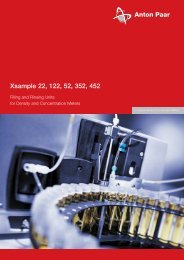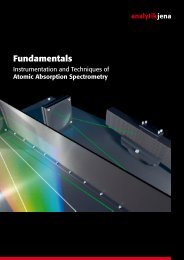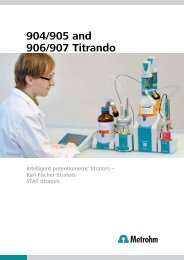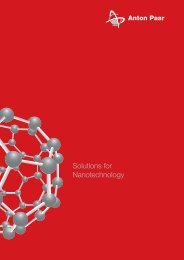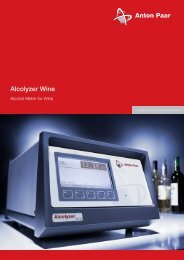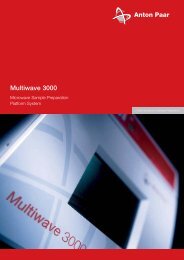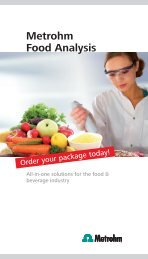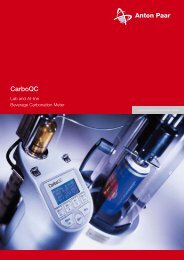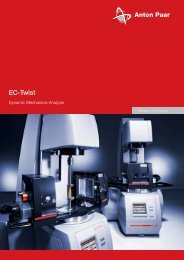Download PDF - MEP Instruments
Download PDF - MEP Instruments
Download PDF - MEP Instruments
You also want an ePaper? Increase the reach of your titles
YUMPU automatically turns print PDFs into web optimized ePapers that Google loves.
TestimonialSample preparation forpesticide residue analysiswith the QuEChERSmethodKnife MillsGRINDOMIX GM 200/GM 300www.retsch.com/gm200www.retsch.com/gm300Mixer MillMM 400www.retsch.com/mm400Preparing foodstuff in a contract laboratoryThe Italian contract laboratory pH s.r.l. is equipped witha variety of sample preparation and analysis toolsincluding some RETSCH mills, such as four Knife MillsGRINDOMIX GM 200, one GRINDOMIX GM 300 and onehigh-speed Ultra Centrifugal Mill ZM 200.pH Lab is involved in food and feed analysis for manyof the major Italian food producers. The neutral-toanalysispreparation of food samples is of crucial importance,especially for the detection of mycotoxinsand pesticides. For this type of analysis it is mandatoryto obtain a fully homogenized sample and to avoidsample heating to preserve the volatile components.pH Lab tries to keep the sample preparation processas efficient as possible. With an average workload of15 to 20 samples per day, time saving is an importantissue. They frequently process vegetable and fruitsamples. For smaller volumes, they use the Knife MillGRINDOMIX GM 200 but if larger quantities need to behomogenized, the bigger GM 300 provides the bestresults as it allows for processing of up to 4,500 mlsample material.With the GM 300 they are able, for example, to processup to 8 bananas in one shot, without pre-cutting thesample. By using the patented gravity lid, whichdynamically reduces the volume of the grinding chamber,they are able to obtain a perfectly homogenizedresult. After the sample preparation they add theQuEChERS reactive solution in order to examine thepesticides contamination. Depending on the sampleproperties, they sometimes mix it with dry ice (ratio2:1) to improve the breaking behavior, using the stainlesssteel container.Mr. Manuele Mecacci of pH Lab is convinced of thebenefits of the GM 300: “We are fully satisfied with theperformance of the new RETSCH GM 300 equipped withthe gravity lid! To obtain such a high degree of homogenizationwas impossible with the equipment we usedbefore. Moreover, the GM 300 helps us to save time asit processes most samples within seconds.”4| the sample 37 | www.retsch.com
“To obtain such a high degree of homogenizationwas impossible before we used theGM 300.”Manuele Mecacci, pH s.r.l.The so-called QuEChERS method (“quick, easy,cheap, effective, rugged and safe”) was developedby Michelangelo Anastassiades (Chemical andVeterinary Investigation Office CVUA, Stuttgart,Germany) to make sample preparation to pesticideresidue analysis more efficient. It basically consistsof three steps: Homogenization – Extraction – Analysis.Test series have proved that the analysis resultsobtained with the QuEChERS method can easily comparewith more common methods, such as DFG S19.During the homogenization process, care must betaken that the sample does not get too warm as somepesticides are volatile. Therefore it is recommendableto cool the sample which also improves the breakingbehavior of the material thus achieving a higher finenessand homogeneity. For this purpose, a speciallid was developed for the GM 300 to be used whengrinding samples mixed with dry ice. An alternativeoption is the RETSCH CryoMill which continually coolsthe sample with liquid nitrogen.After the homogenization, 10 g of the food sample areextracted with 10 ml acetonitrile. As the next step theorganic phase is dried and tested for pesticides withchromatographic analysis. To avoid ghost peaks in thechromatograms, the sample is extracted in the presenceof a salt mixture (e.g. sodium chloride and magnesiumsulphate in a 1:2 ratio). This mixture can beeasily obtained by using a professional sample dividerlike RETSCH’s PT 100. With this rotating divider thesalts are reproducibly mixed so that the compositionof each fraction is identical. In this way, up to 10 saltmixtures can be obtained in reproducible quality.To transfer the pesticides from the sample into theorganic phase, the mixture is agitated for 1 to 3 minuteswith the acetonitrile and salt. The mixture canbe agitated by a laboratory mill such as RETSCH’sMixer Mill MM 400. It moves the sample in a50 mL Falcon tube with a frequency of up to 30 Hzthus ensuring thorough mixing of the sample whichis beneficial for the subsequent extraction.NEWpH s.r.l., ItalyManuele Mecacci with theGRINDOMIX GM 300.The new adapter for theMM 400 allows to use upto 8 Falcon tubes (50 mL)The company pH S.r.l., locatednear Florence, is a leading Italiancontract laboratory founded in1982. It specializes in areas suchas alimentary auto-regulation,safety on work sites, industrialhygiene, environment, quality andtraining, representing, amongother things, a valid support forproduct certification and productionline traceability.PERFORMANCE DATAKnife Mill GRINDOMIX GM 300Applications: size reduction, homogenizationand mixingFeed material: soft, medium-hard, elastic,containing water / fat / oil, dry,fibrousMaterial feed size*: ~ 130 mmFinal fineness*: < 300 µm*depending on feed material and instrument configuration/settingsMixer Mill MM 400Applications: size reduction, mixing,homogenization, cell disruption,cryogenic grindingFeed material: hard, medium-hard, soft, brittle,elastic, fibrousMaterial feed size*: ≤ 8 mmFinal fineness*: ~ 5 µmwww.phsrl.itwww.retsch.com | the sample 37 | 5
TestimonialRecycled glass –a valuable resourceNEWVibratory Sieve ShakerAS 450 controlwww.retsch.com/as450controlJaw CrusherBB 50www.retsch.com/bb51NEWNEWRotating Tube DividerPT 200www.retsch.com/pt200recycled glass is the most important resourceToday,for the glass industry. The processed glass can bereintroduced to the melting process any number of timesand made into new products. In Germany, currently upto 95 % of recycled glass is used for producing glass,which has various advantages: energy saving, less consumptionof primary raw materials (such as lime andsilica sand) and the reduction of landfill costs for wasteglass.The glass which the consumer dumps in the waste container iscollected and processed in modern recycling plants. The wasteglass passes several stations such as opto-physical sortingmachines and magnetic or eddy current separators whichhandle materials such as porcelain, ceramics, stones, metal,paper, plastics, off-colors, glass ceramic and lead glass, ensuringthat the recycled glass is largely free of impurities and canbe reintroduced to the production circle of the glass kilns.Quality control of the recycled glass is of great importance asthe remaining impurities in the glass may cause problems duringor after the melting process. Extraneous materials such asstones or metal produce melting residues, so-called enclaves,in the glass which reduce the stability of the glass, and causeit to break more easily. Whereas most routine inspections inglass kilns or recycling plants are carried out without pretreatmentof the sample and with a mere visual control of theimpurities, the German Institute of Glass and Resource Technology(IGR) always classifies the material with a RETSCHAS 450 control sieve shaker. Thus it is possible to detectconsiderably larger concentrations of impurities which almostmatch the actual percentage in the processed recycled glass.Sample DividerPT 100www.retsch.com/pt1006| the sample 37 | www.retsch.com
IGR – Institute for Glass and Resource TechnologyThe Institute for Glass and Resource Technology situatedin Goettingen, Germany, is an independent servicecompany whose core competence is focused on all subjectsrelated to glass. The IGR is also involved in areassuch as ceramics, refractories, construction materialsand metals, as well as waste. Due to many years ofexperience in the fields of glass production and glassanalysis the IGR has not only acquired profound expertknowledge but has also set up a proven system of qualitycontrol measures which comply with the requirementsof the DIN EN ISO/IEC 17025.www.igrgmbh.dePERFORMANCE DATAJAW CRUSHER BB 51Sample Divider PT 100Applications: Coarse andpre-crushingApplications: Sample divisionand reductionFeed material: medium-hard, hard, Feed material: Bulk materialsbrittle, toughMaterial feed size*: ≤ 10 mmMaterial feed size*: < 35 mmFeed capacity* ≤ 5,000 mlFinal fineness*: < 0.5 mmNumber of divisions: 6, 8 or 10*depending on feed material and instrument configuration/settingsManaging Director DirkDiederich and his colleaguesTo evaluate the quality and applicationareas of the broken glass fragments,analysis of the chemical compositionis crucial. Beside glass-specific elementssuch as silicium, natrium, calcium,magnesium and potassium, thereare also heavy metals to be found suchas lead, cadmium, mercury, arsenicand chromophoric elements such asiron, chrome, cobalt etc.. Usually, onlyvery small sample volumes are usedfor routine analyses in the glass kilnsand recycling plants, and the sampleis not homogenized prior to examination.As a result, the analyzed elementconcentrations vary strongly. Moreover,some of the heavy metals and chromophoricelements are not detectedat all in routine analyses.A guide value for chemically processedrecycled glass is, for example, a contentof ≤ 350 ppm PbO. However, if by chancea single lead glass fragment (24 % PbO)with a weight of 6 g is contained in thetotal sample volume of 10 kg, the PbOconcentration increases by 100 ppm.Consequently, analyzing this samplewould result in a PbO content of 380ppm instead of the original averageconcentration of, e.g., 280 ppm.The most reliable method to obtainrepresentative samples for chemicalanalyses is to reduce the samplein size, if required in two steps,and to divide it. To ensure therequired statistical certainty and accuracyof the analysis results, a homogeneoussample volume of approx.300 kg to 800 kg waste glass isrequired, depending on the elementconcentrations to be detected and themasses to be examined (for examplea truck with a 25 t load or a batch with3,000 t). The IGR divides the entirehomogeneous sample quantity of a few100 kg, crushes it in turn with theRETSCH Jaw Crusher BB 200 (jawsand wearing plates of tungsten carbide)and the Jaw Crusher BB 51 (jaws andwearing plates of zirconium oxide) andfinally divides it representatively withRETSCH’s Sample Divider PT 100.In a next step a homogeneous partsample of 40 g is ground either withthe Planetary Ball Mill PM 100 (agategrinding jar and balls) or with theMixer Mill MM 400 (zirconium oxidegrinding jars and balls). Thanks to thevariety of materials of the grindingtools offered by RETSCH, contamination-freegrinding is ensured.From this sample 0.3 g are taken,various acids are added and the sampleis then thermally treated in specialcrucible, open or closed, and digested.After that the now water-soluble sampleis acidified and filled into a volumetricflask. The sample of recycledglass is finally analyzed with an ICP-OES spectrometer for the concentrationsof more than 30 elements.Thanks to the preparation and analysisprocedure developed and appliedby the IGR, the rather small sampleweight of 0.3 g represents with highstatistical certainty the original samplevolume of 25 t or 3,000 t respectively.This was successfully proved by variousround robin tests and referenceanalyses.www.retsch.com | the sample 37 | 7
TestimonialScrap turned intoraw materialsARNCar RecyclingNetherlandsEU directive 2000/53/EG stipulates that as ofThe2015 95 % of the weight of a car that has reachedthe end of its life span have to be recycled. The work ofARN is strongly focused on this objective. Together withpartner companies they make sure that old cars are processedin an environmentally compliant way. The recyclingchain begins with the companies that dismantle the carand remove raw materials and liquids. Waste managementcompanies collect these materials and deliver themto the processing companies who reuse the materials inaccordance with high production standards.ARN (Auto Recycling Nederland)was founded by the automobileindustry in 1995 following thepassing of an EU directive whichstipulates that cars have to besustainably exploited at the endof their life span. ARN see themselvesas an advisory body withina network of 300 partnercompanies who guarantee a veryeffective process from the dismantlingof the car and the disposalof waste to the actualrecycling.Ultra Centrifugal MillZM 200www.retsch.com/zm200www.arn.nlCutting MillSM 300 with cyclone-suctioncombinationwww.retsch.com/sm30010| the sample 37 | www.retsch.com
“Working with RETSCHequipment is a pieceof cake!”Anita van Ooijen, ARNEnd-of-life vehicles re-usedIn April 2011, ARN opened a productionsite at Tiel which forms the last chainlink in the transformation processof shredded waste to reusable rawmaterials.RETSCH equipment: “We use RETSCHmills and sievers because we know theywork well and are easy to operate andclean. Working with RETSCH equipmentis a piece of cake!”Planetary Ball MillPM 100www.retsch.com/pm100Vibratory Sieve ShakerAS 450 controlwww.retsch.com//as450controlAfter a car wreck has been emptiedand dismantled, the remaining partsare put into a shredder. The resultingshredded light scrap (without metals)is then separated into 3 fractions: rawsand, raw fluff and raw granulate.These fractions are delivered to ARNwhere they are processed and refinedin highly modern production facilities.Marcel van der Veer, Manager Qualityand Environment, explains: “Our productionfacilities are designed for100,000 tons per year. We are planningon processing all of the Dutch shredderlight scrap which amounts to35,000 tons. The recycling of car scrapwill of course remain our main task butit is also conceivable that we will infuture process electronic scrap andplastic waste as well in order to producewith maximum capacity.”To ensure reliable inbound and outboundinspection, the laboratory at Tielis very well equipped. Their customersare critical and very demanding whenit comes to the quality of the recycledraw materials supplied by ARN: “Wedeliver, for example, materials for thedewatering of sludge in wastewatertreatment plants. Or heating materialfor furnaces where the operator needsto know in detail what kind of materialis burnt”, explains lab coordinatorAnita van Ooijen.For these reasons, constant qualitycontrol is a big issue at Auto RecyclingNederland. Typical analyses include,for example, the determination of ashcontent, dry matter content, calorificvalue as well as the PCB and PAC content.Moreover, the percentage of minerals,oils or heavy metals is determinedas well as the nitrogen, carbonor sulfur content.The variety of materials which ARNproduces is great. Therefore, the labhas acquired several different RETSCHinstruments to prepare the requiredanalytical samples. Anita van Ooijenappreciates the good quality of theFor the grinding of fibers and plastics,which are pre-chilled in liquid nitrogen,the laboratory uses a RETSCH CuttingMill SM 300. Anita van Ooijen: “TheSM 300 is perfectly suited for grindingplastics!”RETSCH’s Ultra Centrifugal MillZM 200 is used to grind small piecesof rubber which are also pre-cooledwith LN 2, whereas the RETSCH PlanetaryBall Mill PM 100 predominantlygrinds the hard-brittle componentsof the shredded waste. Anita van Ooijencomments that “the PM 100 providesexcellent grinding results; wemerely use a bit of methanol to preventthe sample from caking to the jar walls.”Working with the ZM 200Particle size analysis is also an issue atARN laboratory in Tiel as the particlesize distribution of a product, amongother factors, influences further processingand use. For this application,the lab uses RETSCH’s VibratorySieve Shaker AS 450 control whichseparates up to 25 kg of sample materialvery efficiently, even with shortsieving times.available at:<strong>MEP</strong>instrumentsThe right chemistry.www.retsch.com | the sample 37 | 11
PERFORMANCE DATA“We were advised by our colleaguesfrom Chicago to use the RETSCH airjet sieve and they were right.”Evgenia Slavina, Wm. Wrigley Jr.Air Jet Sieving Machine AS 200 jetApplications: separation, fractioning,particle sizedeterminationFeed material: powdersMeasuring range*: 10 µm - ~ 4 mmMax. batch: 0.3 - 100 gMax. Number of fractions: 1 (by usinga cyclone: 2)Vibratory Sieve ShakerAS 200 controlApplications: separation, fractioning,particle sizedeterminationFeed material: powders,bulk materials,suspensionsMeasuring range*: 20 µm - 25 mmMax. batch: 3 kgMax. number of fractions: 9 / 17*depending on feed material and instrumentconfiguration/settingsTest sieving of talc powder forchewing gum productionIn the testing laboratory of the St. Petersburg branch of LLC WrigleyRETSCH sieve shakers AS 200 jet and AS 200 control are utilized forparticle size analysis of fine powders which are used for chewinggum production.“Regular sieving machines cannot separate finepowders such as talc”, explains EvgeniaSlavina, a Quality Assurance Specialist inthe testing laboratory. “Talc is used in chewinggum production to prevent adhesion of platesin the package (a so-called “rolling compound”).The fineness of the powder should not exceed40 microns. The air jet sieving machine AS 200jet helps us to control this parameter here inour laboratory. We were advised by our colleaguesfrom Chicago to use the RETSCH air jetsieve and they were right. We use it with the powerful industrial vacuum cleaner GM80which provides sufficient airflow to break the agglomerates. Thanks to adjustablenozzle speed and open mesh function the AS 200 jet is very flexible and makesthe sieving process easy and totally reproducible.”In confections manufacture the fineness of acids also plays an important role. It shouldnot exceed 150 microns to provide the desired solubility of the product. Sieving of suchpowders in an air jet sieving machine is a faster and more reliable alternative to vibratorysieving.RETSCH’s vibratory sieve shaker AS 200 control is also used in the laboratory forfractional analysis of sugar and different sweeteners. The reproducibility of the sievingprocess due to digital control of all parameters, as well as a wide range of high qualitytest sieves make handling of this instrument reliable and easy.Wm. Wrigley Jr.The Wm. Wrigley Jr. Company isa recognized leader in confectionswith a wide range of product offeringsincluding gum, mints, hardand chewy candies, lollipops, andchocolate. The company has operationsin more than 40 countriesand distributes its brands in morethan 180 countries. Wrigley isheadquartered in Chicago, USA,and operates as a subsidiary ofMars, Incorporated, a private,family-owned company foundedin 1911. Since 1992 the companyoperates in the Russian market.It owns a factory in Saint Petersburgwhich was built in 1998.www.wrigley.comwww.retsch.com | the sample 37 | 13
“Our global customers demand consistent quality and performance from our productswithout any site-to-site process variances. The implementation of theCAMSIZER XT systems at our four regional manufacturing facilities will allow usto measure and adjust our powder intermediates produced to ensure that we areable to achieve these global consistency requirements in our end products.”Frank Wiesinger, Global Process Engineering Group – Powder Coordinator,Cookson Electronics / Alpha Advanced Materialswhich operates with Dynamic ImageAnalysis, measures the particle size distributionof all standard solder powderswith utmost precision and high resolution.The CAMSIZER XT not only optimizes thequality control of the end products butalso the monitoring and control of intermediateproduction steps.For solder powders it is crucial to havea narrow particle size distribution,meaning that all particles should haveabout the same size. This is usuallyachieved in a two-step process: First,the liquid metal is dropped on a rotatingdisk, a so-called “atomizer”. This generatesfine, almost round solder beads.Depending on the desired type of powderand required grain size, differentprocess parameters have to be chosen.This raw powder is then sieved to obtainthe desired narrow size distribution.Oversize and undersize are melted againto be re-used with the raw material.To obtain the maximum yield, the atomizershould already produce a narrow sizedistribution with a high percentage ofpowder in the desired size range, ensuringthat the subsequent sieving onlyproduces a small amount of rejects. AsCAMSIZER XT delivers fast and accuratesize results, it helps to rapidlyoptimize the settings of the atomizerand minimize rejects.The precise measurement even of smallestamounts of oversize and undersizeallows for close monitoring of the sievingprocess during production. Wear or blockageof sieves can be detected at anearly stage. This helps to maximize maintenanceintervals and, at the same time,maintain consistent product quality.Dynamic Image Analysis offers variousadvantages for measuring solder powderscompared to other methods suchas sieve analysis or laser diffraction:n Simultaneous measurement of particlesize and particle shape (sphericity,aspect ratio)n Fast and reliable detection of smallestamounts of oversize and undersizen Reproducible and comparable measuringresults at all production sitesn Quick optimization of production parametersthanks to short measuring timesn Simple and safe operation, software invarious languagesn Robust, maintenance-free design allowsfor usage in the laboratory as well asin a production environmentavailable at:<strong>MEP</strong>instrumentsThe right chemistry.Q 3[%]percent by volume90807060type 2type 5type 6type 7type 3type 4 non-round round◄ Comparison of the sphericityof the solder powders504030201000.4 0.5 0.6 0.7 0.8 0.9 SPHTsphericityOptical Particle AnalyzerCAMSIZER XTwww.retsch.com/camsizerxtwww.retsch.com | the sample 37 | 15
Stocked in AustraliaOrder your sieves from <strong>MEP</strong> today – quote“The Sample” and receive the free<strong>MEP</strong> coffee mug with each order!*The most commonly requestedsieves are held on stock by<strong>MEP</strong> for your convenience.Contact Garethat gp@mep.net.au or (02) 8899 5200 nowfor stock listing and pricing.*subject to availability.<strong>MEP</strong>instrumentsThe right chemistry.• Subject to technical modification and errors • 99.997.0037/E • Sources of licensed pictures used in this publication: www.istockphoto.com, www.shutterstock.comGermany:Retsch GmbHRetsch-Allee 1-542781 HaanAvailable in Australia at:<strong>MEP</strong> <strong>Instruments</strong> Pty LtdUnit 11, 56 Buffalo RdGladesville, NSW 2111Available in New Zealand at:<strong>MEP</strong> <strong>Instruments</strong> Ltd2 B, Unit D, 5 Ceres CourtMairangi Bay, Auckland, 0630Phone +49 (0) 21 04 /23 33 -100Fax +49 (0) 21 04 /23 33 -199E-Mail info@retsch.comWeb www.retsch.com16 | the sample 37 | www.retsch.comPhone +61 2 8899 5200Fax +61 2 8899 5299E-Mail info@mep.net.auWeb www.mep.net.auPhone +64 9 912 1330Fax +64 9 912 6892E-Mail info@mep.net.nzWeb www.mep.net.nz



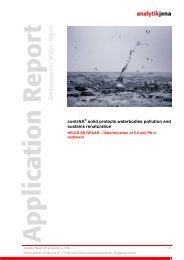
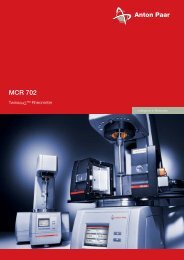
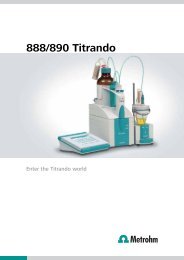
![Rice, size measurement of broken grains [pdf] - MEP Instruments](https://img.yumpu.com/46724497/1/184x260/rice-size-measurement-of-broken-grains-pdf-mep-instruments.jpg?quality=85)
